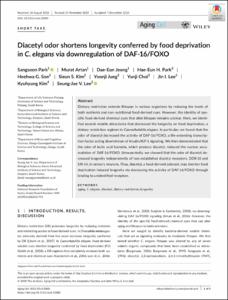Department of Brain Sciences
The K. Kim Lab of Neurobehavior and Neural Circuits
1. Journal Articles
Full metadata record
| DC Field | Value | Language |
|---|---|---|
| dc.contributor.author | Park, Sangsoon | - |
| dc.contributor.author | Artan, Murat | - |
| dc.contributor.author | Jeong, Dae‐Eun | - |
| dc.contributor.author | Park, Hae‐Eun H. | - |
| dc.contributor.author | Son, Heehwa G. | - |
| dc.contributor.author | Kim, Sieun S. | - |
| dc.contributor.author | Jung, Yoonji | - |
| dc.contributor.author | Choi, Yunji | - |
| dc.contributor.author | Lee, Jin I. | - |
| dc.contributor.author | Kim, Kyuhyung | - |
| dc.contributor.author | Lee, Seung‐Jae V. | - |
| dc.date.accessioned | 2021-01-22T07:15:49Z | - |
| dc.date.available | 2021-01-22T07:15:49Z | - |
| dc.date.created | 2021-01-13 | - |
| dc.date.issued | 2021-01 | - |
| dc.identifier.issn | 1474-9718 | - |
| dc.identifier.uri | http://hdl.handle.net/20.500.11750/12700 | - |
| dc.description.abstract | Dietary restriction extends lifespan in various organisms by reducing the levels of both nutrients and non-nutritional food-derived cues. However, the identity of specific food-derived chemical cues that alter lifespan remains unclear. Here, we identified several volatile attractants that decreased the longevity on food deprivation, a dietary restriction regimen in Caenorhabditis elegans. In particular, we found that the odor of diacetyl decreased the activity of DAF-16/FOXO, a life-extending transcription factor acting downstream of insulin/IGF-1 signaling. We then demonstrated that the odor of lactic acid bacteria, which produce diacetyl, reduced the nuclear accumulation of DAF-16/FOXO. Unexpectedly, we showed that the odor of diacetyl decreased longevity independently of two established diacetyl receptors, ODR-10 and SRI-14, in sensory neurons. Thus, diacetyl, a food-derived odorant, may shorten food deprivation-induced longevity via decreasing the activity of DAF-16/FOXO through binding to unidentified receptors. © 2020 The Authors. Aging Cell published by the Anatomical Society and John Wiley & Sons Ltd. | - |
| dc.language | English | - |
| dc.publisher | Blackwell Publishing Ltd | - |
| dc.title | Diacetyl odor shortens longevity conferred by food deprivation in C. elegans via downregulation of DAF-16/FOXO | - |
| dc.type | Article | - |
| dc.identifier.doi | 10.1111/acel.13300 | - |
| dc.identifier.wosid | 000603670900001 | - |
| dc.identifier.scopusid | 2-s2.0-85098487949 | - |
| dc.identifier.bibliographicCitation | Aging Cell, v.20, no.1, pp.e13300 | - |
| dc.description.isOpenAccess | TRUE | - |
| dc.subject.keywordAuthor | aging | - |
| dc.subject.keywordAuthor | C. elegans | - |
| dc.subject.keywordAuthor | diacetyl | - |
| dc.subject.keywordAuthor | dietary restriction | - |
| dc.subject.keywordAuthor | longevity | - |
| dc.subject.keywordPlus | LIFE-SPAN | - |
| dc.subject.keywordPlus | CAENORHABDITIS-ELEGANS | - |
| dc.subject.keywordPlus | DIETARY RESTRICTION | - |
| dc.subject.keywordPlus | OLFACTION | - |
| dc.subject.keywordPlus | RESPONSES | - |
| dc.citation.number | 1 | - |
| dc.citation.startPage | e13300 | - |
| dc.citation.title | Aging Cell | - |
| dc.citation.volume | 20 | - |
| dc.description.journalRegisteredClass | scie | - |
| dc.description.journalRegisteredClass | scopus | - |
| dc.relation.journalResearchArea | Cell Biology; Geriatrics & Gerontology | - |
| dc.relation.journalWebOfScienceCategory | Cell Biology; Geriatrics & Gerontology | - |
| dc.type.docType | Article | - |
- Files in This Item:
-
 기타 데이터 / 524.19 kB / Adobe PDF
download
기타 데이터 / 524.19 kB / Adobe PDF
download
- Appears in Collections:
- Department of Brain Sciences The K. Kim Lab of Neurobehavior and Neural Circuits 1. Journal Articles



